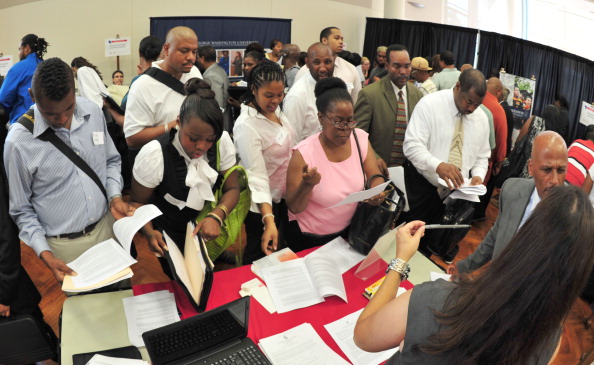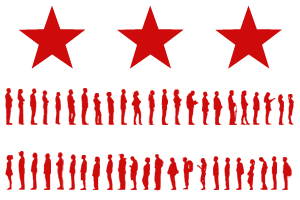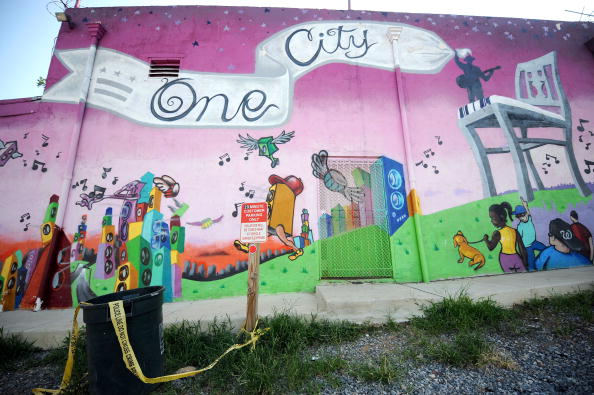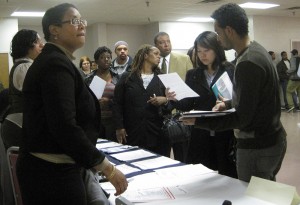Division of Labor: Examining D.C.’s Unemployment Disparity
First in a series.

Karen Bleier / Getty Images
Hundreds of job seekers attended the D.C. Universities Job Fair for District Residents in July 2011, hoping to find work with one of nine District universities.
Gary Veney hasn’t had a steady job for about two years now. He takes odd jobs, such as painting or carpentry, whenever he can find them but he’s been looking for something more stable. So he recently stopped by a neighborhood nonprofit for help. He left with five copies of a typed-up resume, an email account and a plan to apply for as many jobs as possible.
“Sometimes it’s hard to get a perfect job, but anything can help in the meantime,” he said.
Veney doesn’t live in Detroit or Cleveland, places that have come to epitomize the recession, unemployment and struggling Americans. Veney lives in Washington, D.C., a prosperous city by multiple measures.
Unlike most cities, D.C.’s housing prices are rising, according to the S&P/Case-Shiller index. Cranes stretch into the sky in some neighborhoods as workers erect new buildings. People from around the country continue to flock to the nation’s capital for work. And most importantly: D.C. has more jobs than residents.

Image: Carrie Moskal / WAMU
"Division of Labor" is DCentric's examination of D.C.'s unemployment disparities.
Yet, large sections of the city — including Ward 8, where Veney lives — are facing Depression-era unemployment rates. More than a quarter of residents in that part of town are out of work, according to the D.C. Department of Employment Services.
Job creation isn’t D.C.’s problem. The reasons for the disparity in unemployment are complex and interwoven.
DCentric will examine the causes and possible possible solutions in a series of stories starting this week: Who is unemployed? Can motivated people find jobs? What is the impact of criminal records on residents looking for work? Are immigrants making it harder for U.S.-born residents to get hired? And finally, how do college-bound D.C. youth view their communities and their futures?
The Face of D.C.’s Unemployed
D.C. is divided into eight wards, and those areas with the highest concentrations of low-income and African American residents also face the highest unemployment rates. Conversely, those with the highest concentrations of wealthy and white residents have the lowest unemployment rates.
Unemployment and Racial Make-up of D.C. Wards
Source: U.S. Census Bureau, D.C. Department of Employment Services, 2002 Ward boundaries. Map created by Seth Liss, DCentric editor, and Brendan Sweeney, Kojo Nnamdi Show producer.
Many of those struggling with unemployment lack higher education or even high school diplomas. Incarceration is another significant factor. About 60,000 D.C. residents – 10 percent of the city’s population — have criminal records. A recent Council for Court Excellence study suggests about half of D.C.’s ex-offenders may be unemployed.
Community Effects of High Unemployment
Large-scale joblessness affects everyone in the community, not just the unemployed and their families. Businesses are less likely to open in areas where people don’t have as much disposable income. Social service agencies spend more public money to support the unemployed. Young people have fewer working adults to look to for success stories.
D.C. Councilwoman Yvette Alexander represents Ward 7, where unemployment was about 18 percent in September. She said the community feels the high unemployment rate in a number of ways, from poverty to “socioeconomic-based crime” such as shoplifting and small-time drug dealing. That can create a cycle of crime.

Tim Sloan / Getty Images
A mural celebrating "One City" east of the Anacostia River, where unemployment and violent crime is high. Nearby is police tape from a crime scene.
Veney sees the effects of unemployment in his community, too. Ward 8, where unemployment is about 26 percent, leads the city in violent crimes, according to the Metropolitan Police Department.
“I see a lot of crime going on. It’s a lot of bad things,” he said. “My main concern, my fear, is for the kids because they don’t deserve a lot of the things going on.”
LIFT-DC, the nonprofit Veney visited on a recent afternoon for job search help, has a branch in Ward 8. The organization helps connect people to jobs, affordable housing and financial assistance.
“What I see in Ward 8 is a very resilient community, a very hopeful community,” LIFT-DC Executive Director Raël Nelson James said. “But it’s a community that is often ignored.”
The fact that other parts of D.C. have been somewhat buffered from the downturn can exacerbate the problem. Sometimes “people feel discouraged and angry” when they see economic success in neighboring communities but not for themselves, said Valarie Ashley of Southeast Ministry, another nonprofit in Ward 8 that offers adult education and job training. “It’s one of the things, frankly in our classes, that we have to help people manage because they can get so hung up in their anger.”
Ashley said that more people are coming to her organization for help in recent months. Joblessness isn’t a new problem for many of these neighborhoods, and some people have had to deal with poverty in their families for generations. But the recession has made matters worse.

Elahe Izadi / DCentric
Residents read over information from the D.C. Department of Employment Services during a Ward 8 jobs town hall. More than 100 people attended.
“Communities that typically struggle, if you look at recession times, they struggle even worse,” said Dan Brannen, executive director of Covenant House, a D.C. nonprofit serving homeless and at-risk youth. “Things get harder because competition gets harder. When employers aren’t hiring, that’s the double whammy.”
Such dim prospects and chronic unemployment in Veney’s community hasn’t put a damper on his job search: “I think it’s going to be real great for me. I can’t speak for every one and every person, but I can speak for myself.”
Read all “Division of Labor” stories here.
-
Ward7Res
-
http://www.facebook.com/profile.php?id=649140887 Christi Toomer
-
Roman Editor




